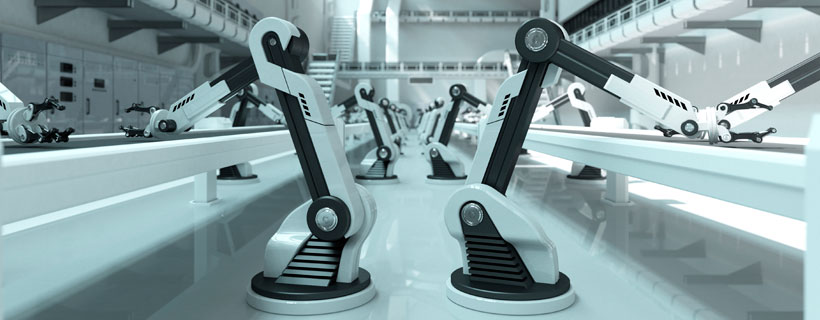Being human

Read time: 12 minutes | Published in Hays Journal 11
Ever since the days of the Industrial Revolution and the time of the Luddites, humans have strived to find a balance between the benefits of modern machinery and the need – or desire – for human involvement in tasks and production.
The seemingly relentless march of technology, then, is nothing new, but it is undeniably gathering pace. The economist John Maynard Keynes even spotted the issue as far back as the 1930s, talking about the risk of ‘technological unemployment’ as technology outpaced human capability to perform routine manual work. Robots are now common in factories; decisions are made in record time through the use of big data – much of it trawled from social media; tasks that would previously have been performed by humans are now undertaken by software programmes; and the emergence of 3D printing presents the possibility of bypassing shops and manufacturing plants altogether, allowing the fabrication of parts and products at home or in the workplace.
"EVERY PERSON'S JOB IS LIKELY TO BE CHANGED BY AT LEAST 25% OVER THE NEXT DECADE" - Leslie Willcocks, LSE
Moshe Vardi, Professor in Computational Engineering at Rice University in the US, recently forecast that robots will have taken over most jobs in just 30 years’ time, leading to unemployment rates of 50 per cent. Similarly, a report by Deloitte and the University of Oxford in the UK warned that 10 million jobs would be lost to computers or robots in the next two decades.
“Certain sectors, such as manufacturing, are more susceptible to automation than others,” says Steve Hearsum, a Development Consultant at Roffey Park. “It’s happening already with the advance of selfcheckouts in supermarkets, self-check-ins at airports and machines replacing librarians. Next in line are swathes of knowledge workers and professionals (such as engineers, doctors or accountants) who, until now, have seen themselves as safe.
“For example, finance functions are likely to see their numbers reduced as ever more tasks can be taken on by algorithms. HR is not immune either; as workforce demographics change, highly skilled knowledge workers sell their skills to different employers, and supporting functions can be outsourced, they will simply have a lot less to do, so not as many will be needed.”
Changing the game
This is already having an impact on jobs, and in some cases, even entire industries. “In the last ten years, technology has enabled organisations to solve problems or deliver products that have resulted in lots of people losing out because you can do more with less,” says Dr Tom Hoyland, a lecturer in Organisational Behaviour and HR at Hull University Business School. He gives the example of multinational retailer Blockbuster, which had more than 80,000 employees, but was effectively replaced – along with others in the sector – by Netflix, which employs significantly fewer people. He even believes his own discipline could be affected by the development of a new computer by MIT, which is capable of producing academic journals.
Nowhere is this felt more, though, than in manufacturing. Leslie Willcocks is Professor of Technology, Work and Globalisation at the London School of Economics and Political Science (LSE), and co-author of Service Automation: Robots and The Future of Work. A recent focus for him and his co-researcher, Mary Lacity, has been the use of robotic process automation (RPA), which the two expect to see a significant take-up of in 2016.
“RPA involves configuring software robots to carry out standardised, routine tasks using structured data that, quite frankly, human beings really do not like doing and are not best suited to perform,” he says. “The software is now mature enough to be easily and cheaply adopted, it is noninvasive in that it only addresses the presentation layer of the organisation’s IT system, and it needs no great special technical skill from staff to configure, run and manage.” One business he has come across already uses RPA to run 35 per cent of its back of its back office processes, he adds.
Computer systems have even been applied to professions that many thought unlikely to be automated. IBM’s Watson is capable of reading 40 million documents in 15 seconds. It is capable of analysing information extremely quickly to answer questions put to it, even winning US TV game show Jeopardy. The platform is now being applied to medical diagnostics with oncologists in America using it to recommend treatments for lung cancer.
Professor Carl Perrin, Director of the Institute for Advanced Manufacturing and Engineering, says the real change is in the use of big data and how machines connect together. “It affects the whole supply chain, in terms of customers giving an indication around when they want the product, through to planning and scheduling. This tells the machine what product is coming through which allows rapid configuration of tooling. This in turn enables the extraction of data from the manufacturing process itself to understand the health of the machine, so we can anticipate when maintenance needs to be done,” he says. “All of those things rely on data and processing, and being able to adapt how we run the business and machines. That’s where the big opportunities are in front of us.”
Adapting to change
While the advances will mean some roles are no longer necessary, they do offer a fantastic chance to create new or adapted professions. In the face of the growing use of technology, businesses and the world of work are adapting to the evolving environment. Willcocks points out that studies forecasting huge job culls tend to overlook the potential for new roles to be created. “Certainly our work suggests every person’s job is likely to be changed by at least 25 per cent over the next decade, as technology increasingly permeates task performance,” he says.
“But the forward-casting studies we have done with corporations suggest that for every 20 jobs lost from the combined impact of technologies such as SMAC (social media, mobile, analytics and cloud), digital fabrication, Internet of Things, big data, knowledge automation and robotics, another 13 will be gained,” he says. Two areas in particular will require significant numbers of people as a direct result of new technology in the fields of big data itself and the regulation that will emerge around it.
Hoyland also predicts that there will be winners, pointing to the emergence of a whole generation of internet companies as an example of how technology can change, rather than destroy, the jobs environment. “It enabled people who didn’t have the traditional power networks and access to funding to start businesses that have gone on to be incredibly successful,” he says. “So this will create great opportunities for people too.”
Time to train
HR will have an important role to play in helping businesses make this transition. According to Roffey Park’s Management Agenda 2016 research, 59 per cent of organisations are currently looking to implement new technology, and the challenge is to make sure this is done in a way that works for the business as a whole. “The danger is that new technology is seen as the emperor’s new clothes of 2016 because, without changing the culture and behaviours that exist, it will be merely a fad that fails to have the desired impact,” says Hearsum. “The consistent refrain I hear from digital leaders through to those in HR, learning and development and organisational development is that the challenges of technology, while real in technical terms, are infinitely more complex and demanding when it comes to designing and developing organisations that are fit for purpose in terms of culture and behaviour, not least at senior leadership levels.”
"THE HUMAN TOUCH IS INDISPENSABLE TO CREATIVITY AND MANAGING THE UNPREDICTABLE" - Valérie Claude-Gaudillat, Audencia Business School
Professor Valérie Claude-Gaudillat, Director of the Institute for Innovation, Design and Entrepreneurship at Audencia Business School in France, says HR has a number of roles in ensuring a smooth transition, including empowering workers and developing skills to meet new industry requirements. “This means developing technology- and sector-specific skills, but also more transversal skills, such as communication, critical thinking and creativity,” she says. “Companies should build on the skillsets of their long-term employees by allowing them to keep up with the peace of new technologies.” Mixing teams of older and younger workers to share knowledge can help ensure everyone understands new ways of working, and no one gets left behind, she adds.
In some environments, HR should look to retrain people who may otherwise find their jobs displaced by technology, believes Perrin. “There’s no reason why someone who has been in the business for many years doing a manual job – such as a press operator – couldn’t retrain and be a robot programmer or work with a robot in the future. As long as people are willing to learn and change, then I’d prefer to retrain our own people and give them the skills to evolve with the business, as opposed to getting in someone who understands robots but doesn’t understand manufacturing. There’s a lot of risk with that.”
Taking a step back
Yet there is also some evidence of a pushback. Hoyland points to the experiences of both IBM and Yahoo, which have sought to scale back from being overly reliant on technology due to fears that some human interaction is being lost. “Technology cannot replicate the chance meeting within the organisation where chit-chat unveils common problems or builds linkages,” he says. “Organisations like Google and Facebook are now creating spaces and environments for people who want to hang out and talk, and the key reason for that is to bring about that cross-fertilisation of ideas, and the important relationships that are built in the workplace itself.”
Willcocks also points out that technology cannot replace roles that require human empathy. “Capabilities like empathy, creativity, intuition, judgement, tacit knowing, and the human need for social interaction and peer judgement are not at all easy to replicate in specific contexts,” he says. “Humans have a facility to combine any or all of these in ways that machines are unlikely to master. In our own study of service automation, we found plenty of examples where these skills were vital, whether in healthcare, insurance, utilities, service providers or legal services. “The challenge for organisations is to take the best elements of both, combining the processing power of technology with the softer skills and lateral thinking of humans.
“The ideal mix is one that combines the best of both worlds: effciency and productivity for technology; creativity, problem solving, emotion, complexity management and close relationships with stakeholders for the workforce,” says Claude-Gaudillat. “Technology cannot discover new drugs, find adapted answers to complex problems or be creative. The human touch is indispensable to creativity, to solve high-level problems and to manage the unpredictable.”
Mark Sear, CTO, EMEA of cloud computing and data storage business EMC, agrees. He says while programs like IBM’s Watson can sift through vast amounts of data faster than a person ever could, there are areas where a human touch is required. “Ultimately you can’t automate emotion. You can attempt to, and you can even get very close, but consider something like the medical profession. It’s possible now for a computer to give you almost a better diagnosis than a doctor. But do you want a computer to tell you if you have cancer? That’s why you need the human side to that profession. You need to be able to have that interface and break bad news in an empathetic way, or good news in a wonderful way. I think all solutions where automation is possible will still need ahuman touch.”
A measured approach
In manufacturing, there are already signs that the ultimate solution may involve humans working alongside technology, rather than being replaced by it. Perrin gives the example of the Cobot – short for collaborative robot – which is designed to work on assembly lines, complementing work done by people. “There is a trend now to recognise the benefits of people and robots working together,” he says. “So the robot might perform repetitive tasks which are not good for humans to do because of the repetitive strain injury implications, but where there are still some interfaces with humans needed.”
Sear says a balanced solution can give better results, utilising technology to improve effciency while incorporating a human touch to cut errors. He gives the example of staff picking out products for mailing in warehouses. “Warehouses are normally laid out in aisles. A computer will give you a ‘pick route’ and this will move you down an aisle collecting products, then back, then up, then back, then up. The issue is people get really bored, and if they follow the same route again and again, it becomes more boring still and they make more mistakes. Deliberately changing routes and the layout of the warehouse in a way that encourages workers to stop and have a quick chat, just for one or two minutes, alleviates the boredom and massively improves their accuracy.”
There are also ethical concerns around the proliferation of technology, and automation in general. Hoyland, for instance, points to concerns around work-life balance as a result of technology. People can be contacted round the clock in a way not possible previously. There are also fundamental concerns about what happens when technology can make decisions so quickly that humans are unable to comprehend the implications before it is too late. “Technology has outpaced the evolution of the brain,” he says. “A key driver of the financial crisis of 2008 was the ability to perform credit swaps so quickly, and we’re not able to keep up with that decision making ourselves.” A similar situation could arise with big data, he warns, where individual employees can end up making significant, yet snap, decisions, on the basis of a computer interpretation.
Time to change
In any case, reports of the demise of humans in the workplace may prove to be somewhat premature, at least in the next few years. Willcocks believes it will be the softer elements around management and culture that slow down the mainstream adoption. “Our work on cloud computing, robotics and service automation finds that the road to the diffusion of such technical innovations into real businesses is much longer and more arduous than many reports portray or wish,” he says.
“Even with RPA, we found 25 lessons to be learned on how to manage these technologies, covering strategy, launch, organisational readiness, change management, and how to build an enterprise-wide capability. The pushback may well be on assuming too much about what the technology can do, and underestimating how much human qualities are needed to run successful organisations.”
Sear adds that a common mistake for many businesses automating for the first time is to go too far, too fast. He says organisations should be prepared to take a step back. “The most important thing to do is to break automation down into pieces and work on those which will give you the biggest bang per buck. To use the warehouse example again, if you can reduce your pick error rates by 90 per cent by carrying out basic automation, ask why you are pushing for that last 10 per cent. Ultimately, you’ll be very lucky to get them and the cost of the automation will likely outweigh the saving. You have to automate what makes sense.”
Claude-Gaudillat, meanwhile, warns of the dangers of repeating mistakes from the past. “Automated customer services have proven very disappointing and negative for corporate images,” she points out. “Who wants to wait dozens of minutes to only get a vague answer? Companies which have re-instilled high-level human interactions in combination with e"cient technologies are the ones that create more value in the marketplace.”
| This article is published in Hays Journal 11 |




